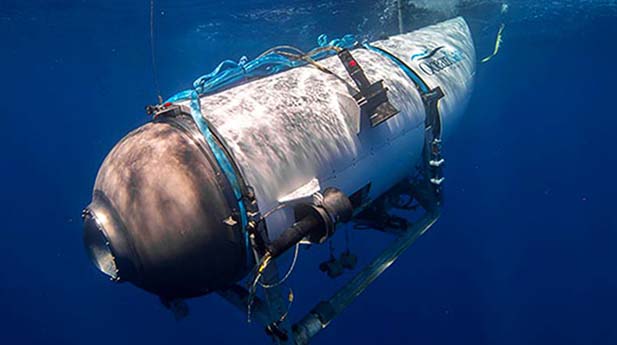Missing Titanic Sub: Crew Faces Oxygen Depletion at Treacherous Depths
Trapped in a 22ft submersible, potentially thousands of feet beneath the ocean’s surface, with depleting oxygen levels – a claustrophobic and terrifying scenario.
The fate of the Titanic submersible and its five-person crew remains uncertain.
If the vessel remains intact, time is of the essence as it is believed to have only a few hours of oxygen left, intensifying the race to locate the sub before it’s too late.
Nonetheless, the timeline is not set in stone. Dr. Ken LeDez, an expert in hyperbaric medicine at Memorial University in St. John’s, Newfoundland, shared with BBC News that the survival duration of those on board could exceed expectations depending on various factors.
“It depends on how cold they get and how effective they are at conserving oxygen,” he explained. Shivering expends a significant amount of oxygen, whereas huddling together can help retain heat.
Dr. LeDez described the depletion of oxygen as a gradual process, unlike flicking off a switch, likening it to ascending a mountain where falling temperatures and declining metabolism impact the rate of ascent.
Acknowledging the limited information available regarding the conditions inside the submersible, Dr. LeDez noted that the circumstances may differ for each individual.
He admitted that although it is a disconcerting topic, some crew members might survive longer than others.
Rear Admiral John Mauger of the US Coast Guard addressed the numerous uncertainties surrounding the search and rescue mission. “We do not know the rate of oxygen consumption per person inside the sub,” he stated in an interview with the BBC.
Dr. LeDez also emphasized that running out of oxygen is not the sole peril faced by those aboard the vessel.
The loss of electrical power likely plays a role in regulating oxygen and carbon dioxide levels within the submersible.
As oxygen levels decline, the proportion of carbon dioxide exhaled by the crew increases, potentially leading to fatal consequences.
“As carbon dioxide levels rise, it becomes sedative, like an anesthetic gas, and you will fall asleep,” Dr. LeDez warned.
Excessive amounts of carbon dioxide in the bloodstream, known as hypercapnia, can prove fatal if left untreated.
Ryan Ramsey, a former captain in the Royal Navy’s submarine division, expressed concern after reviewing online videos showcasing the interior of the Titan.
He found no evidence of carbon dioxide scrubbers, systems responsible for removing the gas. “To me, that is the most significant problem of all,” Ramsey stated.
Simultaneously, the crew is susceptible to hypothermia caused by the body’s excessive cooling. According to Capt. Ramsey, if the submersible rests on the seabed, the water temperature would be approximately 0°C (32°F). Without electricity, the submersible cannot generate heat.
However, Dr. LeDez remarked that hypothermia might offer a glimmer of hope. “There is a possibility that if they cool down enough and lose consciousness, they could survive – rescuers are aware of this,” he said, highlighting the body’s innate adaptability to enhance survival chances.
Nevertheless, the flip side to hypothermia, oxygen deprivation, and carbon dioxide buildup inside the submersible is that the crew’s ability to establish contact with the search and rescue mission dwindles.
Banging on the hull periodically to attract attention becomes increasingly challenging due to unconsciousness.
“If they’re unconscious, they won’t be able to do much to help themselves,” Dr. LeDez pointed out.
While the Coast Guard warns of limited remaining oxygen, the crew might be able to conserve their supplies for some time.
Ramsey suggested that slowing down their breathing would be helpful, although he acknowledged the difficulties stemming from the immense stress they are undoubtedly experiencing.
Dr. LeDez proposed other strategies, such as distributing carbon dioxide-absorbing materials or reducing power consumption if electricity is still available.
Regarding food and water, the Coast Guard stated that the crew possesses limited rations on board but couldn’t provide specifics.
Despite the multitude of challenges, Dr. LeDez cautions against prematurely calling off the search and rescue operation, believing that even with critically low oxygen levels, the crew could potentially survive.
“If anyone can endure such conditions, it’s these individuals,” he remarked. “It depends on whether they have power and light to find things and operate the controls. But absolutely, they might still be alive.” 263culture/BBC
Missing Titanic Sub: Crew Faces Oxygen Depletion at Treacherous Depths





